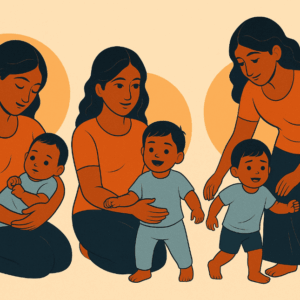Separation-Individuation: Understanding the Foundation of Self-Development in Psychoanalytic Theory
 Introduction
Introduction
The concept of Separation-Individuation occupies a central position in psychoanalytic developmental theories, particularly through the pioneering work of Margaret Mahler. This theory describes a crucial developmental phase wherein an infant gradually moves from a state of psychological symbiosis with the mother towards establishing a distinct, autonomous sense of self.
Understanding this process is essential not only in child development but also in comprehending the roots of adult psychopathologies such as Borderline Personality Disorder (BPD), narcissistic vulnerabilities, and difficulties in interpersonal relationships.
Origins of the Theory
Margaret Mahler, a Hungarian-born psychoanalyst, developed the Separation-Individuation Theory of Child Development in the 1960s and 70s through detailed longitudinal studies of mother-infant pairs. Mahler proposed that personality disorders and relational dysfunctions in adulthood often stem from disruptions during this early developmental phase.
Phases of Separation-Individuation
1. Normal Autistic Phase (0–2 months)
-
Earlier theorized by Mahler but later revised.
-
Infant is primarily focused inwardly with minimal awareness of the external world.
2. Normal Symbiotic Phase (2–5 months)
-
Infant perceives self and mother as one fused entity.
-
The mother’s presence is experienced as part of the infant’s undifferentiated self.
3. Separation-Individuation Phase (5–24 months)
This phase is central to Mahler’s theory and is broken into subphases:
a. Differentiation (5–10 months)
-
The infant begins to recognize the mother as a separate being.
-
Exhibits behaviors like stranger anxiety and heightened alertness to external stimuli.
b. Practicing (10–16 months)
-
With newfound motor abilities (crawling, walking), the child begins to explore the environment.
-
The child still uses the mother as a secure base but enjoys physical autonomy.
c. Rapprochement (16–24 months)
-
Child oscillates between seeking independence and needing closeness.
-
Experiences ambivalence: desires autonomy yet fears abandonment.
-
Hallmarked by emotional storms and the demand for emotional refueling from the mother.
d. Consolidation of Object Constancy (24 months onwards)
-
The child achieves a stable internal representation of the caregiver.
-
Can tolerate physical or emotional separation because of the secure internalized image of the mother.
Clinical Relevance in Psychiatry
1. Borderline Personality Disorder (BPD)
Patients with BPD often struggle with object constancy, leading to unstable interpersonal relationships, intense fear of abandonment, and splitting behaviors. These reflect unresolved conflicts from the rapprochement phase.
2. Narcissistic Personality Disorder (NPD)
Failures during the practicing phase may lead to fragile self-esteem structures that require constant external validation.
3. Therapeutic Implications
Psychotherapy often revisits these early dynamics, helping patients:
-
Develop a more integrated self-image.
-
Achieve stable object representations.
-
Tolerate separation without overwhelming anxiety.
Cross-cultural Considerations
In cultures like India, where interdependence and familial closeness are culturally normative, the process of separation-individuation may unfold differently. Clinical assessment should distinguish between developmental pathology and cultural norms of relatedness.
Conclusion
The Separation-Individuation Process remains a vital framework for understanding the roots of self-development, identity formation, and relational patterns. Its disruption can have far-reaching implications for mental health. As clinicians, appreciating these early dynamics enriches our understanding of personality development and informs therapeutic strategies aimed at fostering a cohesive, resilient self.